Fashion Nova Black and White Long Sleeve Dress
Black and White Long Dress
Black and White Long Dress: this style of fashion just fascinates me. There is magic in these gowns, whether more classy or contemporary in style. The very first one below, by Ikko Tanaka, is my absolute favour. And, yes, I do admit that I am an ardent fan of Japanese fashion designers!

Ikko Tanaka: Second Collection for Issey Miyake
Born in 1930 in Nara City , Ikko Tanaka studied art at the Kyoto City School of Fine Arts . Ikko Tanaka worked at the Sankei Shinbun, Nippon Design Center , and subsequently established his first design studio in Tokyo, the Ikko Tanaka Design Studio, in 1963. Tanaka was ranked the freshest Japanese designer of the 20th century by GQ in 2001.
Ikko Tanaka's work includes the design of the symbols for Expo '85 in Tsukuba and World City Expo Tokyo '96. Amongst others he has worked for the Seibu Saison Group , The International Garden and Greenery Exposition , Hanae Mori , Issey Miyake , and the Mazda Corporation. Tanaka has curated and designed exhibitions for the Victoria and Albert Museum (London) and throughout Japan. He has also designed the main logo of Osaka University . Ikko Tanaka published several books, including "Design, no Zengo Sayu." and an autobiography, "Tanaka Ikko: graphic master".
Ikko Tanaka is credited with developing the Muji together with Kazuko Koike (marketing consultant), and Takashi Sugimoto (interior designer). Tanaka articulated the Muji vision and appearance, and he provided ideas and prototypes that visualized the design strategy. He worked as Muji 's art director until 2001. In September 2012 there was a retrospective of his work at 21 21 Design Sight in Tokyo, curated by one of his closest collaborators Kazuko Koike .
His work is held in the permanent collections of many museums worldwide, including the USC Pacific Asia Museum , the Walker Art Center , the Museum of Modern Art , the Indianapolis Museum of Art , the University of Michigan Museum of Art , the Cooper Hewitt , the Museum of Applied Arts and Sciences , the British Museum , the Nasher Museum of Art , the Artizon Museum , and the Victoria and Albert Museum.
Ikko Tanaka has received several awards, including the JAAC Special Selection, Mainichi Design Award, Minister of Education Newcomer Prize, Tokyo ADC Members' Grand Prize, Mainichi Art Award, Purple Ribbon Medal, and the New York ADC Hall of Fame Prize. Tanaka has exhibitions in New York, Los Angeles, Paris, Mexico.
Black and White Long Dress: House of Worth
The House of Worth can be easily regarded as the beginning of Haute Couture, as it has produced works of art by combining colours and textures and by using meticulously chosen textiles and trims. The fact that so many examples have survived in such good condition is testament not only to the popularity of Worth among wealthy patrons but also to the quality of textiles insisted upon by Charles Frederick Worth.
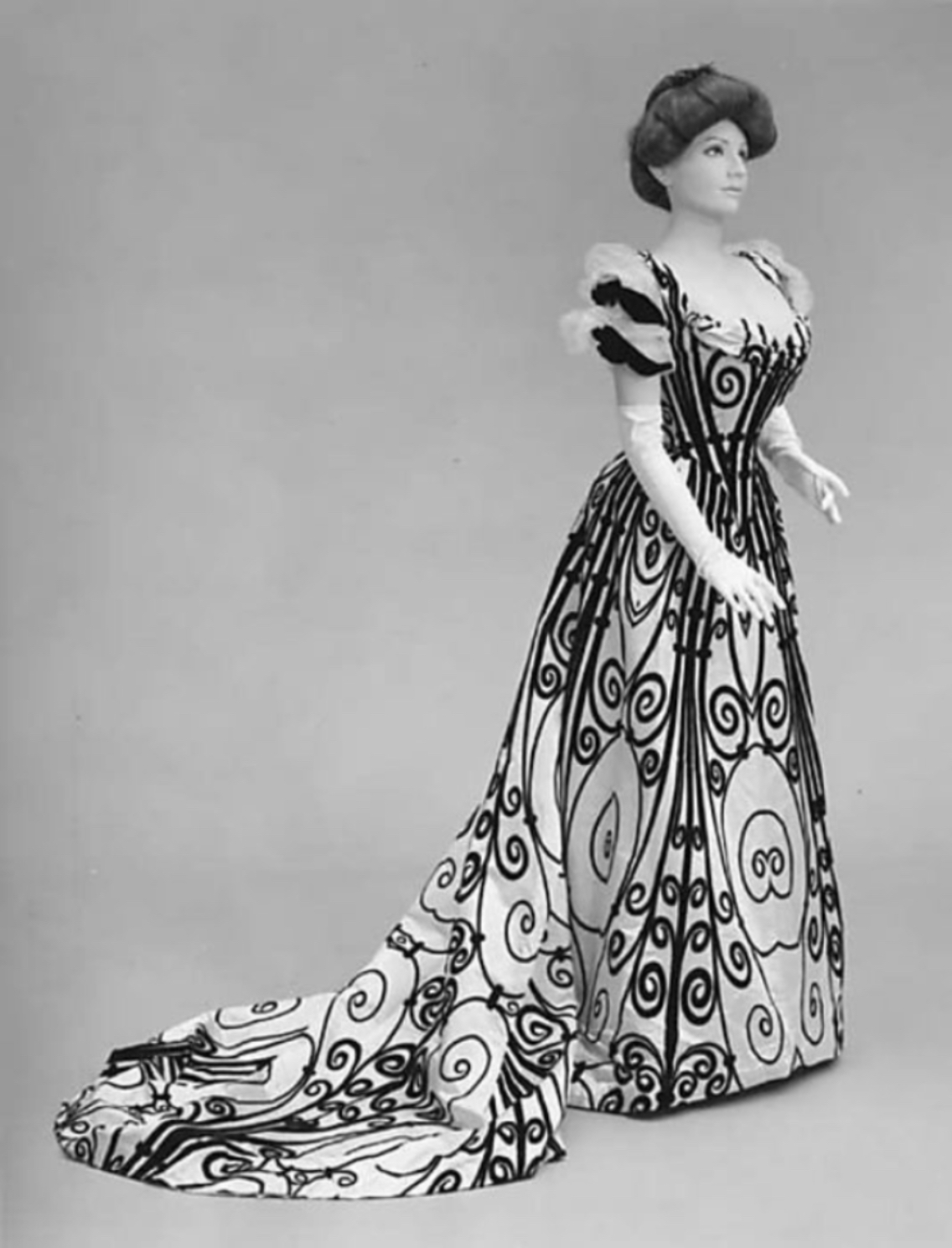
1900 Evening Dress. Silk. Metropolitan Museum of Art, NYC.
Black and White Long Dress: History
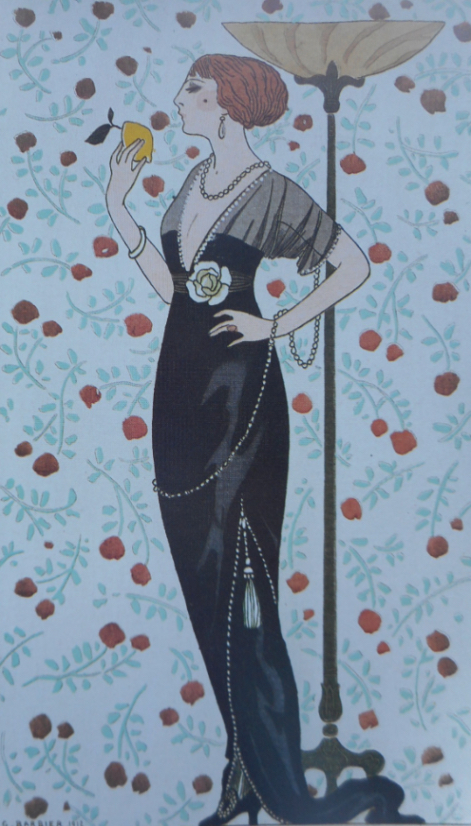
Black satin and tulle evening gown added with brilliants. Drawn by George Barbier. Paris, 1912-14.
George Barbier ( French: [ʒɔʁʒ baʁbje] ), né Georges Augustin Barbier , (1882–1932) was one of the great French illustrators of the early 20th century. Born in Nantes , France on 16 October 1882, Barbier was 29 years old when he mounted his first exhibition in 1911 and was subsequently swept to the forefront of his profession with commissions to design theatre and ballet costumes, to illustrate books, and to produce haute couture fashion illustrations. For the next 20 years Barbier led a group from the Ecole des Beaux Arts who were nicknamed by Vogue "The Knights of the Bracelet"—a tribute to their fashionable and flamboyant mannerisms and style of dress. Included in this élite circle were Bernard Boutet de Monvel and Pierre Brissaud (both of whom were Barbier's first cousins), Paul Iribe , Georges Lepape, and Charles Martin . During his career Barbier also turned his hand to jewellery, glass and wallpaper design, wrote essays and many articles for the prestigious Gazette du bon ton . In the mid-1920s he worked with Erté to design sets and costumes for the Folies Bergère and in 1929 he wrote the introduction for Erté's acclaimed exhibition and achieved mainstream popularity through his regular appearances in L'Illustration magazine. Barbier died in 1932 at the very pinnacle of his success. He is buried in Cemetery Miséricorde , Nantes.
The following image is a portrait of the Irish actress and singer Daisy Irving who starred in the musical play, 'The Count of Luxembourg'. The actress is dressed in a gown designed by Paul Poiret: I am not sure whether the dress was made in 'black and white'; however, it is just too beautiful to ignore!

Daisy Irving. Dress by Poiret Haute Couture, Paris, 1910.
Paul Poiret (20 April 1879 – 30 April 1944, Paris, France) was a leading French fashion designer , a master couturier during the first two decades of the 20th century. He was the founder of his namesake haute couture house. His contributions to his field have been likened to Picasso 's legacy in 20th-century art .
Poiret established his own house in 1903. In his first years as an independent couturier, he broke with established conventions of dressmaking and subverted other ones. In 1903, he dismissed the petticoat, and later, in 1906, he did the same with the corset. Poiret made his name with his controversial kimono coat and similar, loose-fitting designs created specifically for an uncorseted, slim figure.
Poiret designed flamboyant window displays and threw sensational parties to draw attention to his work. His instinct for marketing and branding was unmatched by any other Parisian designer, although the pioneering fashion shows of the British-based Lucile (Lady Duff Gordon) had already attracted tremendous publicity. In 1909, he was so famous, Margot Asquith, wife of British Prime Minister H. H. Asquith , invited him to show his designs at 10 Downing Street . The cheapest garment at the exhibition was 30 guineas, double the annual salary of a scullery maid.
Poiret's house expanded to encompass interior decoration and fragrance. In 1911, he introduced "Parfums de Rosine," named after his daughter, becoming the first French couturier to launch a signature fragrance, although again the London designer Lucile had preceded him with a range of in-house perfumes as early as 1907. In 1911 Poiret unveiled "Parfums de Rosine" with a flamboyant soiree held at his palatial home, attended by the cream of Parisian society and the artistic world. Poiret fancifully christened the event "la mille et deuxième nuit" (The Thousand and Second Night), inspired by the fantasy of a sultan's harem. His gardens were illuminated by lanterns, set with tents, and live, tropical birds. Madame Poiret herself luxuriated in a golden cage. Poiret was the reigning sultan, gifting each guest with a bottle of his new fragrance creation, appropriately named to befit the occasion, "Nuit Persane." His marketing strategy, played out as entertainment, became the talk of Paris. A second scent debuted in 1912 – "Le Minaret," again emphasizing the harem theme.
Black and White Long Dress: in The 1920's

Paris set the fashion trends for Europe and North America. The fashion for women was all about letting loose. Women wore dresses all day, everyday. Day dresses had a drop waist, which was a belt around the low waist or hip and a skirt that hung anywhere from the ankle on up to the knee, never above. Daywear had sleeves (long to mid-bicep) and a skirt that was straight, pleated, hank hem, or tiered. Hair was often bobbed, giving a boyish look.
Clothing fashions changed with women's changing roles in society, particularly with the idea of new fashion. Although society matrons of a certain age continued to wear conservative dresses, the sportswear worn by forward-looking and younger women became the greatest change in post-war fashion. The tubular dresses of the 'teens had evolved into a similar silhouette that now sported shorter skirts with pleats, gathers, or slits to allow motion. The most memorable fashion trend of the Roaring Twenties was undoubtedly "the flapper " look. The flapper dress was functional and flattened the bust line rather than accentuating it.
The straight-line chemise topped by the close-fitting cloche hat became the uniform of the day. Women " bobbed ", or cut, their hair short to fit under the popular hats, a radical move in the beginning, but standard by the end of the decade. Low-waisted dresses with fullness at the hemline allowed women to literally kick up their heels in new dances like the Charleston . In 1925, "shift" type dresses with no waistline emerged. At the end of the decade, dresses were being worn with straight bodices and collars. Tucks at the bottom of the bodices were popular, as well as knife-pleated skirts with a hem approximately one inch below the knee.
In the world of art, fashion was being influenced heavily by art movements such as surrealism . After World War I, popular art saw a slow transition from the lush, rectilinear abstractions of art nouveau decoration to the more mechanized, smooth, and geometric forms of art deco . Elsa Schiaparelli is one key Italian designer of this decade who was heavily influenced by the "beyond the real" art and incorporated it into her designs.
Proper attire for women was enforced for morning, afternoon, and evening activities. In the early part of the decade, wealthy women were still expected to change from a morning to an afternoon dress. These afternoon or "tea gowns" were less form-fitting than evening gowns, featured long, flowing sleeves, and were adorned with sashes, bows, or artificial flowers at the waist. For evening wear the term "cocktail dress" was invented in France for American clientele. With the "New Woman" also came the "Drinking Woman". The cocktail dress was styled with a matching hat, gloves, and shoes. What was so unique about the cocktail dress was that it could be worn not just at cocktail hours (6 and 8pm), but by manipulating and styling the accessories correctly could be worn appropriately for any event from 3 pm to the late evening. Evening gowns were typically slightly longer than tea gowns, in satin or velvet, and embellished with beads, rhinestones, or fringe.
Black and White Long Dress: in The 1940's
Fashion in the years following World War II is characterized by the resurgence of haute couture after the austerity of the war years . Square shoulders and short skirts were replaced by the soft femininity of Christian Dior 's " New Look " silhouette, with its sweeping longer skirts, fitted waist, and rounded shoulders, which in turn gave way to an unfitted, structural look in the later 1950s.
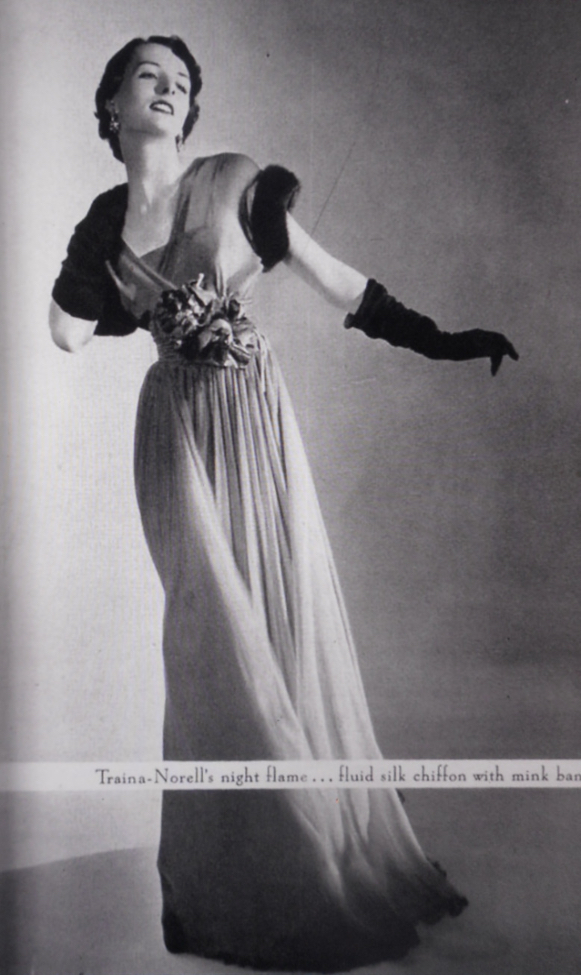
Black and White long dress in 1948.

Judy Garland:Black and White long dress in 1945.
Black and White Long Dress: The New Look Revolution
On 12 February 1947 at 10.30 a.m. Christian Dior, aged 42, presented his first collection at 30 Avenue Montaigne, which was strewn with flowers by Lachaume. The Editor-in-Chief of Harper's Bazaar , Carmel Snow, strongly believed in the couturier's talent, which she had already noted in 1937 with the Café Anglais model that he designed for Robert Piguet. At the end of the fashion show, she exclaimed, "It's quite a revolution, dear Christian ! Your dresses have such a new look! " A correspondent from Reuters seized upon the slogan and quickly wrote it on a note that he threw from the balcony to a courier posted on Avenue Montaigne. The news reached the United States even before the rest of France, where the press had been on strike for a month.
With his revolutionary New Look, Christian Dior wrote a new chapter in the history of fashion. Furthermore, in order to write it, he literally constructed it with his own hands. The designer had to hammer away at a Stockman mannequin that was too tough and unyielding to bear the preparatory canvases of his visionary wardrobe, says his friend Suzanna Luling: "And so, with big, nervous blows of the hammer, he gave the mannequin the same form of the ideal woman for the fashion that he was to launch." His aim was clear; his hand did not tremble. "I wanted my dresses to be 'constructed', moulded on the curves of the female body whose contours they would stylise. I accentuated the waist, the volume of the hips, emphasised the bust, In order to give my designs more hold, I had nearly all the fabrics lined with percale or taffeta, renewing a tradition that had long been abandoned." Thus, on 12 February 1947 at 10.30 a.m., the announcer introduced "numéro un, number one". The first outfit was worn by Marie-Thérese and opened the show during which the audience saw 90 different creations file past, belonging to two principal lines:En Huit andCorolle. Bettina Ballard, Fashion Editor at Vogue, had returned to New York a few months earlier after 15 years spent covering French fashion from Paris: "We have witnessed a revolution in fashion at the same time as a revolution in the way of showing fashion."
The "softness" of the New Look was deceptive; the curved jacket peplum shaped over a high, rounded, curved shoulders, and full skirt of Dior's clothes relied on an inner construction of new interlining materials to shape the silhouette. This silhouette was drastically changed from its previous more masculine, stiff, triangular shape to a much more feminine form.
Throughout the post-war period, a tailored, feminine look was prized and accessories such as gloves and pearls were popular. Tailored suits had fitted jackets with peplums, usually worn with a long, narrow pencil skirt . Day dresses had fitted bodices and full skirts, with jewel or low-cut necklines or Peter Pan collars . Shirtdresses, with a shirt -like bodice, were popular, as were halter-top sundresses. Skirts were narrow or very full, held out with petticoats ; poodle skirts were a brief fad. Ball gowns (full-skirted gown for white tie occasions) were longer than ankle-length dresses (called "ballerina length"), reaching the floor and worn to balls (as they are today). Cocktail dresses, "smarter than a day dress but not as formal as a dinner or evening dress" were worn for early-evening parties. Short shrugs and bolero jackets, often made to match low-cut dresses, were worn. Meanwhile, in Israel, simple Biblical sandals , blue cotton shirts and utilitarian, khaki military-inspired dress remained popular choices for many women due to ongoing economic austerity and the need to feel prepared for war.
Black and White Long Dress: Contemporary Fashion

Black and White Long Dress: Blanka Matragi
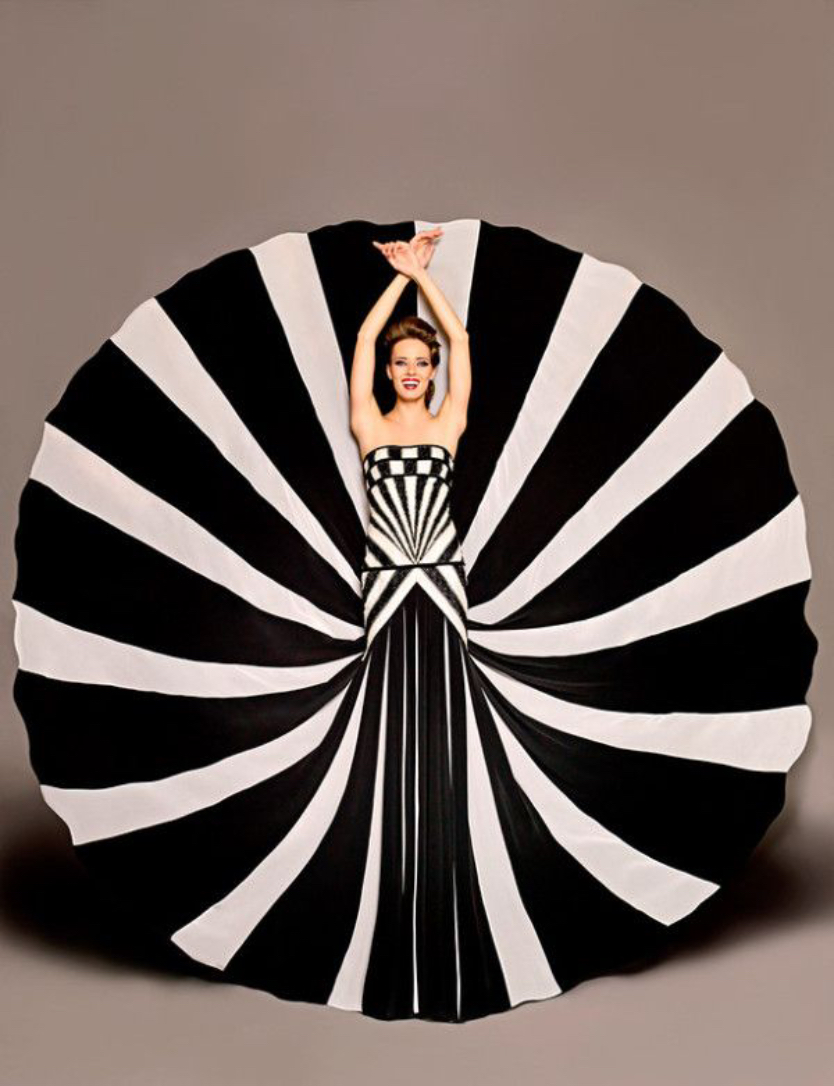
Czech first name Blanka and exotic surname Matragi maps two worlds, between which fashion designer Blanka Matragi moves: the Czech Republic and Lebanon, where she's living and working for twenty five years. Among the books on art celebrity autobiography Blanka Matragi is unique as the first biography of Czech fashion designer. Over twenty years she designs her models for selected members of high society in the countries of the Persian Gulf, and recently also for the exceptional clientele living in the country. With customers from the royal families, as the only foreigner and European, she's getting into an exclusive, completely closed to the public world of local palaces.
Black and White Long Dress: Edward Arsouni

Edward Arsouni Haute Couture-Spring Summer 2016
Edward Arsouni is an Italo-Lebanese fashion designer. Arsouni graduated from Instituto Artistico Marangoni, Milan. He began his fashion design career in the early 90s: he had the honor to work alongside GIANFRANCO FERRE Maison de Couture as well as, ANNA ASCIONE Maison de Couture in Via Spiga, Milan, ITALY.
Shortly after, Arsouni returned to Beirut, Lebanon and established the Edward Arsouni Maison Du Couture.
Since 2002, Edward Arsouni has participated in more than 20 fashion shows and video productions in Lebanon, Italy and the United States.
Arsouni's creations inspire the oriental woman; from modern to traditional and fashionable to classic.
Black and White Long Dress: Carolina Herrera
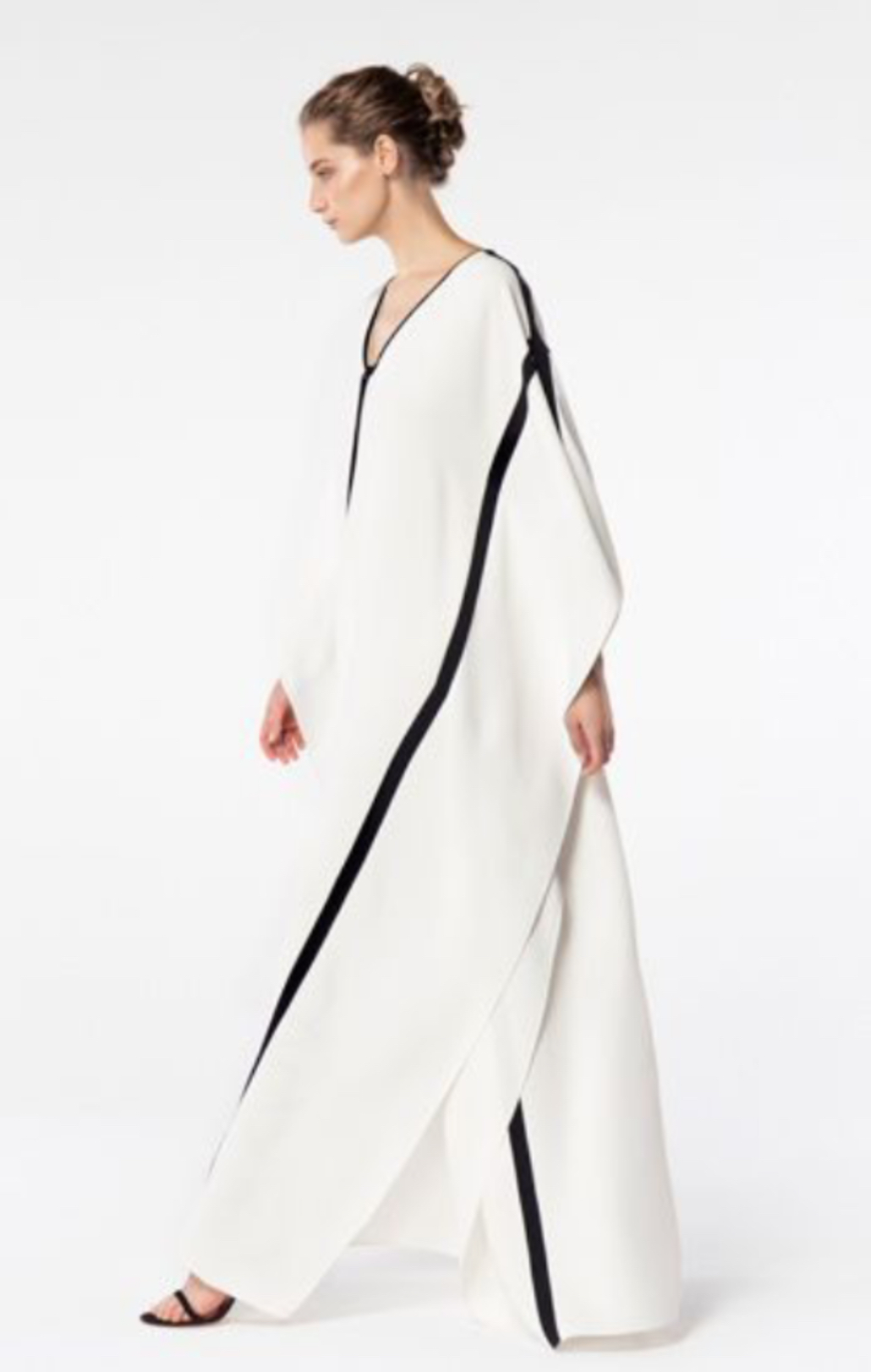
Carolina Herrera (born 8 January 1939 ) is a Venezuelan-American fashion designer known for "exceptional personal style", and for dressing various First Ladies , including Jacqueline Onassis , Laura Bush , Michelle Obama , and Melania Trump .
In 1965, Herrera began her career working as a publicist for Emilio Pucci , a Florentine Marquis himself and a close family friend. She began working at Pucci's Caracas boutique, and moved to New York in 1980. Frequently associating with Mick and Bianca Jagger and Andy Warhol , at Studio 54 , she became well known for her dramatic style. She first appeared on the International Best Dressed List in 1972, then was elected to its Hall of Fame in 1980.[9] In 1981, her friend Diana Vreeland , then Editor-in-Chief ofVogue suggested that Carolina design a clothing line. She did so, having samples made in Caracas, and debuted her collection at Manhattan's Metropolitan Club to critical acclaim. A well known Park Avenue boutique, Martha's, agreed to showcase her clothing in their prominent windows. Upon this initial success, she returned to Caracas and raised capital to fund a more formal launch. Her first runway show in 1980 included future supermodel Iman . Carolina Herrera presents her Ready-to-Wear Collection semiannually at Mercedes-Benz Fashion Week in New York.
The company has been based in New York City since 1980, and in 1981 the brand received recognition from several key publications, includingWomen's Wear Daily andTatler, with particular early attention to her well designed sleeves. A few of her most notable clients have included Jacqueline Kennedy Onassis , who asked her to design the dress for her daughter Caroline's wedding, Diana, Duchess of Cadaval , who asked her to design the dress for her marriage with Prince Charles-Philippe of Orléans, Duke of Anjou , and actress Renée Zellweger .
Black and White Long Dress: Elie Saab
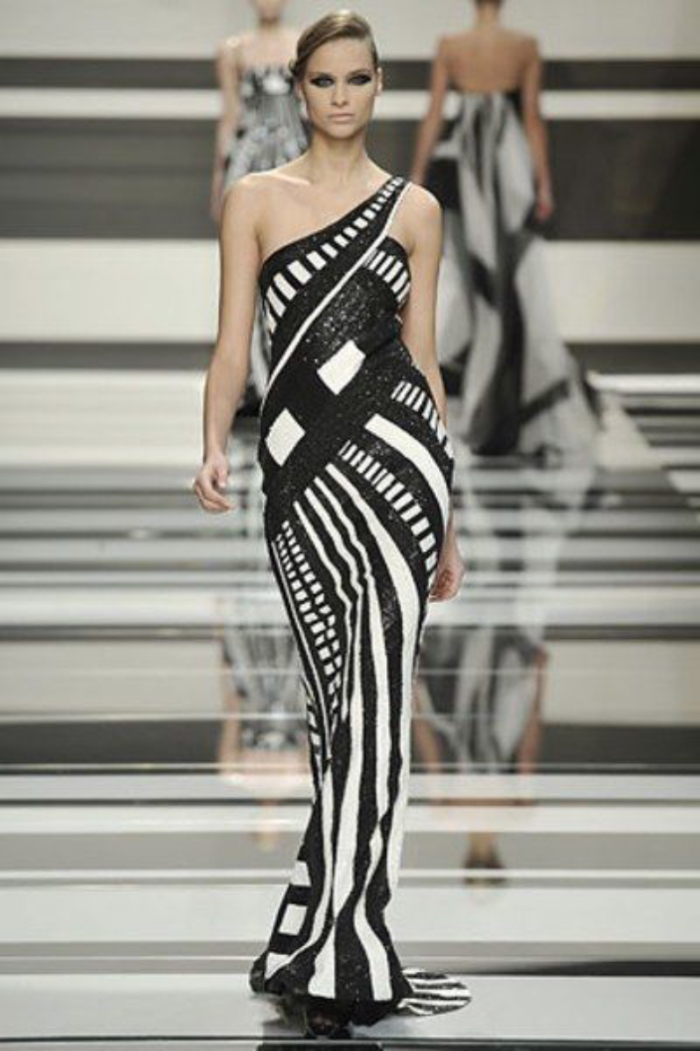
Elie Saab ( Arabic : إيلي صعب) (born 4 July 1964) is a Lebanesefashion designer .
His main workshop is in Lebanon, with additional workshops in Milan and Paris. He started his business in the early 1980s and specialized in bridal couture (expensive fabrics, lace , gemstones, Swarovski crystals, pearls , detailed embroidery , etc.).
He is the first Arab to be admitted to the fashion industry's governing body, Chambre Syndicale de la Haute Couture . Saab appeared as a judge onProject Runway: Middle East in 2016. As of March 2017, his couture collections are available in Paris, London, and Beirut, while his ready-to-wear clothes were in 160 retailers and his own boutiques.
Saab became more well known in the United States after he became the first Lebanese designer to dress an Oscar winner, Halle Berry , in 2002. In May 2003, theChambre Syndicale de la Haute Couture invited him to become a member, and he showed his firsthaute couture collection in Paris in July 2003.
In 2003, he teamed up with Pronovias to create a bridal line, Elie by Elie Saab. (Pronovias is a business headquartered in Barcelona that creates wedding and cocktail wear and dresses for sale.)
The Chambre Syndicale de la Haute Couture inducted him as amembre correspondant in 2006. His first ready-to-wear collection in Paris was the Spring-Summer 2006 collection.
Saab, Tina Knowles , House of Deréon , Giorgio Armani , Versace , and Herve Leger served as the designers for the outfits of the 2007 The Beyoncé Experience tour. In 2010, Saab dressed 102 celebrities for events overall, up from 40 in 2009. The figure for 2011, up until March, was 88. In 2011, Madame Tussauds unveiled a wax statue of Kate Winslet draped in the Elie Saab dress she wore at 63rd Primetime Emmy Awards . In 2011, Elie Saab launched his first fragranceLe Parfum.
Kate Middleton wore an Elie Saab gown while attending the 2019 Royal Ascot with her husband, Prince William . This was the first time one of Saab's gowns was worn by a British royal.
Black and White Long Dress: Edda
This first outfit is NOT a long dress: it is long trousers! However, it could look like a long dress and, besides, I immediately fell in love with it!
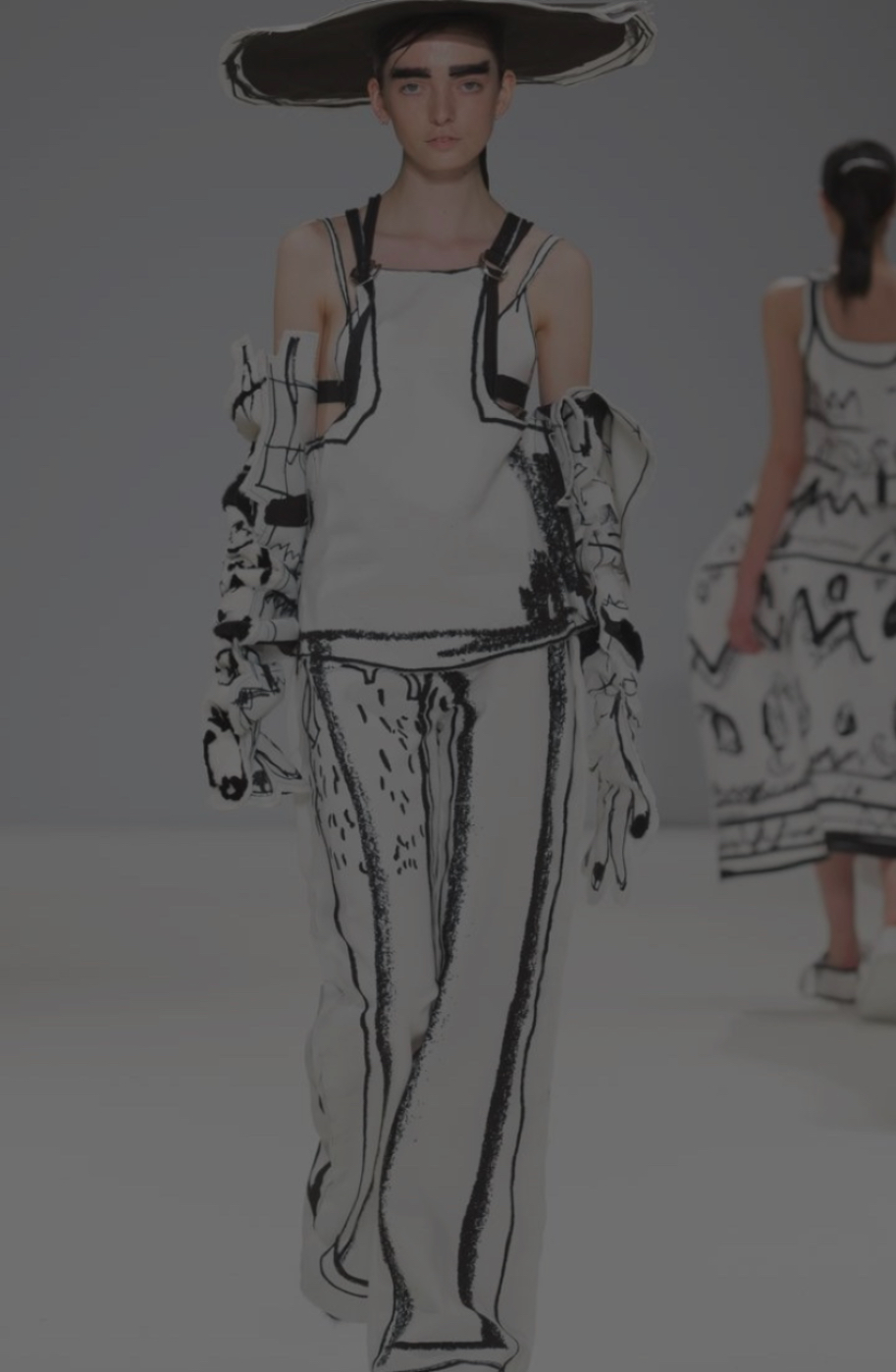

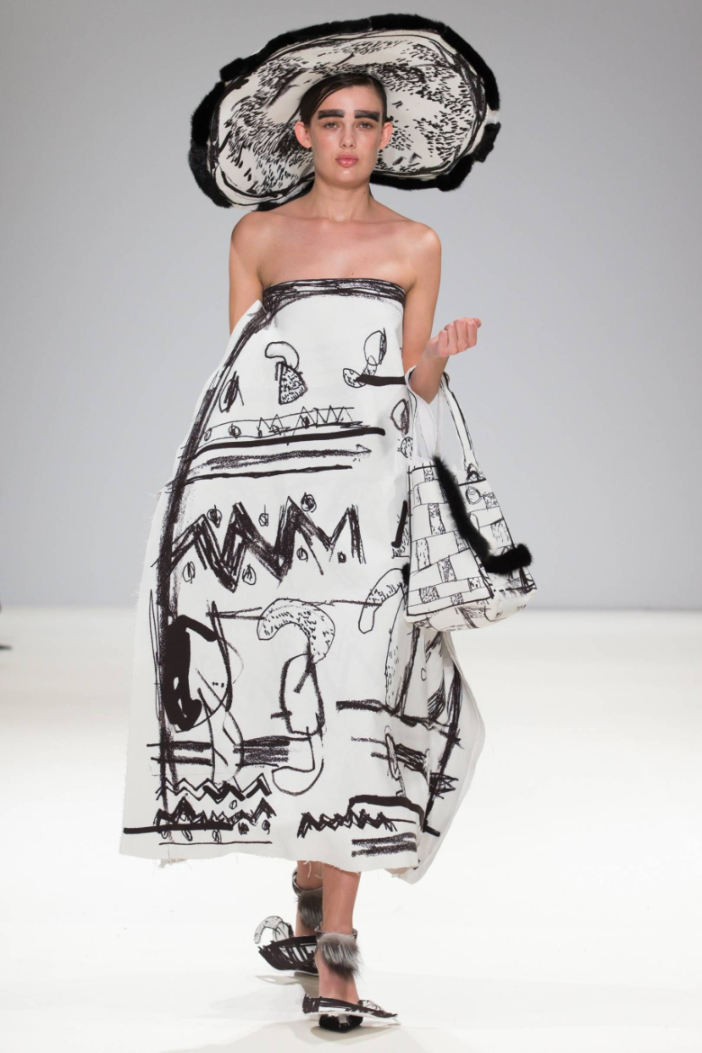
Selected by New York Times as one of 10 "Fresh-Out-of-Fashion-School Designers to Watch", Edda Gimnes has quickly gained a name for herself in the fashion industry. Since graduating from London School of Fashion, her bold statement pieces have been worn by the likes of Lady Gaga, Gigi Hadid and Cardi B. EDDA has been showcased in both museums and art installations.
With experimental executions.The designer draws by her non-dominant hand to create a fun and vibrant expression, and she is a trailblazer when it comes to finding beauty in imperfection. Many of the pieces manifest from small naïve illustrations, that are enlarged, printed onto canvases and turned into functioning garments or accessories.
When it comes to creative collaboration, EDDA has combined fashion and innovation through partnerships with Microsoft, Epson, H&M, Max Mara Group and Disney.
Edda had made a name for herself in Scandinvia and abroad for her surreal scribblea and two-dimensional ready to wear"- Vogue
Black and White Long Dress: Holly Fulton

Holly Fulton (born 1977) is a London-based fashion designer who set up her eponymous fashion label in 2009. Known for bold graphic and 3D motifs, innovative use of textiles and distinctive accessories, she has been described as the "queen of prints". She is a regular at London Fashion Week and has also appeared at Hong Kong Fashion Week .
Holly Fulton designs feature luxurious fabrics, often with Art Deco and retro-inspired prints. The label is also known for its use of decorative embellishments, often in unusual materials, such as perspex and crystal. Women's Wear Daily has noted how the designer often combines: "several disparate sources of inspiration". The autumn 2014 show, for instance, featured calculators, cogs and other technology-inspired motifs.
Black and White Dress: In Black and White and Gray The Cutting Edge Fashion Design Collections
Katerina Stamatelos is a fashion designer, musician (composer and pianist), painter, and poet. She holds a professional degree in fashion design and pattern making as well as five professional degrees in music (piano performance, piano pedagogy, and a PhD in music composition).
Since 2010, Katerina has been chief designer of the Sxisma Fashion House , using various online platforms to create hundreds of fashion items, including home décor. These products can be found in abundance by googling the term "Sxisma Fashion." However, her creativity encompasses far more than these platforms would indicate. She has commented often about the simplicity of available patterns and the commonality of materials.
The publication of her visionary designs fills this void. She has accepted our representation and now feels free to design according to her wishes and take her innovative ideas as far as she is able. We could not be more pleased. The first publication is here!
...
Black and White Long Dress: Back to Fashion Design
Fashion Nova Black and White Long Sleeve Dress
Source: https://www.katerinastamatelos.com/black-and-white-long-dress.html